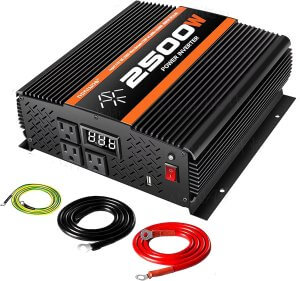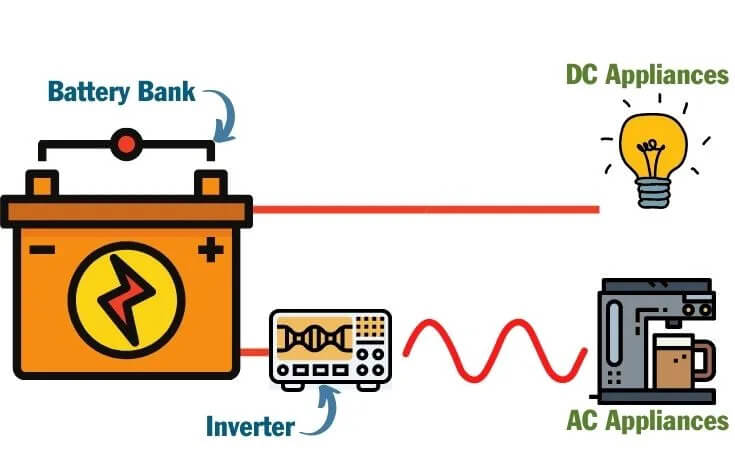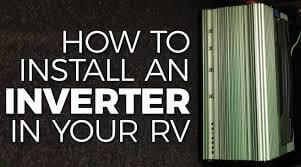RV inverters are essential for your camper, as they provide the power necessary to run electronics and appliances while on the road. These inverters convert the 12V DC power stored in the RV’s batteries into the standard 120V AC power required for most household devices that we are accustomed to using in our daily life.
But before you go ahead and install an RV inverter, it is vital to understand how they work, what to look for, and some tips for a smooth installation process.
What is an RV Inverter?

Your recreational vehicle comes with electrical systems of two different supplies: 110V or otherwise known as Alternating Current (AC), and 12V or otherwise known as Direct Current (DC). The Inverter uses the camper’s battery as the source of energy (12V) and converts it into usable 110V power for your larger appliances like refrigerators or microwave ovens that consume a lot of energy. The appliances that plug into a standard wall socket with two pins also run on 110V of power. Therefore, when you’re boondocking, it becomes essential for you to have an RV inverter connected to your vehicle’s battery.
What is the Difference Between an RV Inverter and a Converter?
An RV inverter converts the 12V DC power into 110V AC power, while a converter does the opposite of this. The converter steps down the 110V AC power into 12V DC power so that the 12V appliances in your RV can utilize this power. Another difference between the two is that the converter needs to be connected to shore power or needs power from an external source such as a generator. This process lessens the voltage supply needed for the 12V equipment, such as the lights and the furnace in your camper.
On the other hand, the Inverter takes the 12V power and raises it to 110V for some of the bigger appliances in your RV, such as the television, refrigerator, or space heater.
What is the Use of an Inverter in an RV?
The RV inverter takes the one-way current of DC power and converts it into a two-way current of AC power. This essentially aids in powering up the heavy equipment in your recreational vehicles, such as the convection oven, electric blanket, or curling iron. These appliances tend to consume more energy than the standard supply in a 12V power system.
Notably, 12V DC power is much more efficient than 110V AC power as it naturally uses a voltage 10x lesser than that of the latter. Therefore, if you’re planning on boondocking, you need to be mindful because you will then be forced to save up the Ampere hours. Additionally, the more you use 12V appliances, and it will keep the Ampere hours at a minimum threshold as compared to using 110V appliances.
How Do RV Inverters Work?

DC power travels in a relatively straight line, and AC power switches and changes direction between positive and negative voltages. An inverter is made up of switches and diodes that keep opening and closing as and when current passes through it.
An RV inverter takes the 12V direct current (DC) and transforms it into 120V alternating current (AC) by increasing the voltage first and then alternates it to find the right balance fit for the equipment it is supplying the current to. In a nutshell, your RV inverter boosts the 12V direct current that goes into it and converts it into a 120V alternating current power supply.
Most higher-end inverters have this feature called bypass circuitry. What this feature does is when your camper is docked and connected to shore power, the Inverter automatically goes into “standby mode” and stops pulling power from the vehicle’s battery, thereby allowing the current from the shore supply to flow directly into the circuits.
Types of Inverters
RV inverters come in three different types, and it is crucial to understand the workings of all three in order to secure the right piece for your camper. They are –
- Sine Wave – The most expensive of the three due to its high capacity, this inverter type has a fairly established spot in the market due to its versatility with how well it supports all types of appliances, including high-power apparatus.
- Modified Sine Wave – These work on a similar wavelength as the sine wave inverter, wherein they are able to support high-energy appliances. However, they are not as expensive and are comparatively less energy efficient than their counterpart. This means they consume a lot more power and can potentially make more noise while activated.
- Square Waves – The most economical of the three, this type of Inverter can only support appliances that run on the alternate current, meaning you will be unable to use the heavier appliances with this Inverter. While this would work for most people who love living in outdoors, it can get challenging to find the right equipment to install this type of Inverter.
Your budget and the type of appliances you’d want to run in your recreational vehicle basically act as the bottom line in getting the right type of Inverter. Therefore, understanding the fundamentals of the different types of inverters becomes paramount as it would eventually help you choose the one that matches your needs the most.
How to Pick the Best RV Inverter
Much like how you do your due diligence before purchasing an RV or the various equipment for an RV, the same principle should be applied while getting an inverter as well. In order to narrow down the various choices available in the market, you must first understand and consider these factors –
Wattage and Power Ratings
Getting an inverter with the right power capacity is extremely important if the end result you’re seeking is for it to power up the appliances in your camper. From the overall power ratings to the regular power consumption to the maximum level of energy output, energy plays a major role here. This is exactly why you should have a clear picture of your power requirements, as it will pave the way for you to accurately pick out a unit that will optimally support your appliances when you’re traveling.
Input and Output Voltage
Having the right input and output voltage is vital for every appliance to work at its optimal levels. At the core, the input voltage should match your camper’s battery. Most RV batteries utilize 12V of power. Therefore, your Inverter should also carry 12V of power for its direct current rating. It is vital that you confirm your RV’s battery numbers before finalizing an inverter.
Generally, direct current is measured in two digits, while alternating current is measured in three digits, so it becomes easy to distinguish between the two types of power supplies.
Energy Efficiency
An RV inverter usually operates at various energy levels, making it very versatile and suitable for your needs. Having said that, ignoring its energy efficiency can leave a considerable dent in your wallet. An inverter will operate at its optimal level when it consumes energy most efficiently. Otherwise, you run the risk of your Inverter eating through your RV battery which further puts a strain on your Inverter.
Size
Inverters always come in different sizes. As is the case with most of your RV upgrades, you’d need to consider how much space and weight the Inverter would take in your camper. The size of the Inverter matters because it determines how long you can power up your appliances. On the other hand, a small inverter will not only provide power but also keep the battery power available for your RV’s engine to function. Then again, this is only for a limited time. If you are someone who intends to use the Inverter over an extended period of time, we advise that you purchase a large inverter.
How to Install an RV Inverter
Now that we’ve got the what and the why of getting an inverter out of the way, it is time to set it up! Listed below are the tools and supplies you will need to install an inverter in your RV –
- Inverter
- Screwdriver
- Wrench
- Fasteners
- Connectors
- Cable
Having secured the tools, let’s get started now!
Make Space for the Inverter
It is essential that you clear out the space where you intend to set your Inverter up because it needs to stay safely secured to an area within your RV. We also advise that you place it near your camper’s battery but also separate the two by keeping the Inverter in a different compartment. You also need to ensure that the unit is not kept under fluids or next to flammable objects and is seated in an area where there is sufficient airflow to keep it cool. The surface you keep the Inverter on should also be non-combustible.
Secure the Inverter
The next step is to attach the RV inverter to the surface. Most inverter units arrive with holes drilled in by the manufacturer, and a screwdriver should come to your service well in these cases. In some cases, you may also need a wrench to drive in lag bolts, so keep a wrench in your toolbox if it comes to that.
When you secure your Inverter, you are making sure that the unit is properly wedged in, preventing any unnecessary back-and-forth movement from damaging it and becoming a hazard for you and your companions living in the camper.
Connecting the Inverter and the Battery
This step involves wiring the Inverter to the vehicle’s battery from where it can draw the power from. It is important that you follow the instructions provided in the manual because connecting the terminals on the Inverter usually differs from unit to unit.
Grounding the Inverter
The last step involves grounding your RV inverter before you start using it. Any inverter unit that you purchase will arrive with a 12V ground cable. You will again need to keep an eye on the user manual to understand the grounding process to ensure you do it right.
Protect the Inverter
Once your RV inverter is installed with all the necessary steps, you also need to safeguard it from power surges that can potentially damage the device. Install an inverter fuse and a surge protector to protect the Inverter from damage in the event of a power surge.
RV Inverter Installation Tips and Best Practices
We’ve listed down some best practices that should aid you in the process of setting up the Inverter in your camper –
Use Smaller Cables
When you are connecting the Inverter to the battery with wires, you need to ensure that the length of the wire is not too long, as that will lead to the Inverter dropping its efficiency, even if the model that you purchased is a high-end one. This factor comes to the forefront, especially when the unit is handling smaller voltage appliances, as you’re more likely to see fluctuations arising as a result of the leakage of power due to long wires.
Use Your Auto Transfer/ Remote Switch
Keep an eye out for the remote switch that comes with the RV inverter. However, this is not the case with all inverters. If your unit does come with a remote switch, you’d need to install this as well. Follow the instructions given in the user manual to ensure that you complete this process the right way.
These switches are also capable of detecting when your camper can operate on shore power and when it can’t and toggle it to the relevant setting as and when is necessary. This feature comes in really handy because it ensures you don’t need to switch things over yourself manually. It also brings in additional safeguards because manual intervention brings a potential safety hazard with it, and it is advised to avoid it as much as possible.
Our Best RV Inverter Picks for your RV
Here are our top picks in every category to help you pick the best Inverter for your recreational vehicle –
- The Most Well-Rounded RV Inverter – Renogy 3000W 12V Inverter
- Best-In-Class RV Inverter – Samlex 3000W- PST-3000-12
- RV Inverter With Extended Warranty – Victron Phoenix 1200VA
- Best Bang For The Buck RV inverter – AIMS Power 3000W Power Inverter
- Best Inverter For Camping In Your Car – Bestek 2000W Inverter
Closing Thoughts
RV inverters are a valuable addition to any recreational vehicle, allowing you to run household appliances and electronics while on the road. By understanding how they work, what to look for when choosing an inverter, and following some simple installation tips, you can ensure that your RV inverter provides reliable and efficient power for all your needs.
Whether you’re a seasoned RV enthusiast or a new adventurer, taking the time to learn about RV inverters and their installation will help you make the most of your time on the road. So, take the time to do your research and find the right RV inverter for you, and enjoy the peace of mind that comes with a well-functioning power system.

